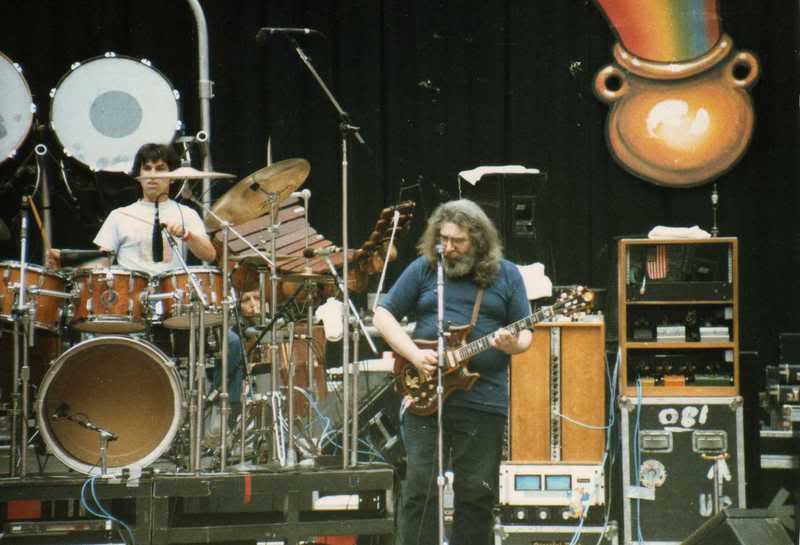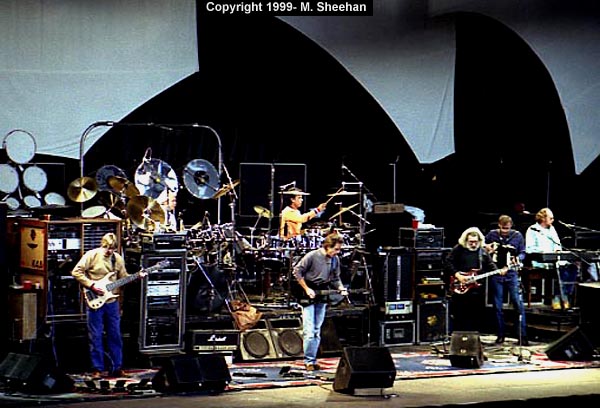
Jerry Garcia Rig History
Jerry Garcia Fender of choice was the Fender Twin Reverb. Early in the Grateful Dead's infancy Jerry only used the amp in it's stock form as a combo amp.
" My First Amplifier with the Warlocks was a Fender Twin Reverb. I bought it in the first year they came out, around 1963 or 1964, I guess. It may actually still be in use. I sold it to Mike Wilhelm of the original Charlatans." J.Garcia - Guitar Player 1978 Interview
The Warlocks 1965

"The OwsleyStein"
February 1966 Watts, L.A. California
"My Stereo became the Grateful Dead PA. It had a Mcintosh amp, two channels, 40 watts per channel." - Owsley "Bear" Stanley
"It served several purposes," Tim Scully explained. "One, Bear wanted to do direct recording of the electric instruments, and he bought a decent 1/4" stereo Ampex tape deck, I had to build a preamp/mixing board to produce a mixed stereo signal from all the electric instruments, plus the drums and vocal mics. Two, he wanted to provide monitor speakers, which would let the band hear this mixed sound as they played. Three, he wanted the audio to be as clean and undistorted as practical. For example, we wanted to avoid unintentional clipping, and I brought along my Tektronix scope, which we used to monitor the signals to ensure that we weren't clipping. Four, he wanted to reduce the hum and noise picked up by cables from the instruments to the mixing board. We put good-quality audio transformers in each instrument, mounted close to the pickup, which reduced the high impedance signal to a 600-ohm balanced line, and used good-quality rubber-jacketed microphone cable and XLR connectors at the mixing board end to connect each instrument to the mixing board. Another audio transformer was at the mixing-board end of each instrument's line, bumping the signal back up to high impedance before going to an FET input circuit. Finally, the box had a preamp for each channel- each instrument- with volume and crude bass and treble controls. There were preamps and mixing controls for the PA mics, too." - Tim Scully
Mcintosh Amps
Altec Lansing's Voice of the Theatre Speakers.
The Mcintosh amps were mounted to a thick piece of plywood they called, the "Lead Sled"
1966 Troupers Hall

"It finally got to the point where it was just not working and everybody sat down and said, 'Hey, it's not working,' and I said, 'I agree with you.' And they said, 'Well, we want to do something different.' I said, 'Fine, go to the music store and pick out what you want. I'll buy all the stuff you have now, for the amount of money it takes to buy all this stuff you need.'" -Owsley "Bear" Stanley
In an early 1967 interview Billy noted, "We got $4,000 and bought some Fender equipment." Garcia added, "Good old reliable Fender equipment, and some Sunn equipment."
Sausalito 1967 (Rehearsal)

1967
"What I use is two fifteens, two fifteens(unintelligible) two JBL's in a Dual, you know, Dual Showman cabinet. I use a Dual Showman cabinet plus High Frequency Horns plus my Twin Reverb. The Twin Reverb powers everything." - Jerry Garcia 710 Ashbury Spring 1967
3/20/1967

6/21/1967

7/4/1967
Showman Head is added to power the 15" speakers and High Frequency Horn if used. The Twin Reverb remains main amp and input is shared with the Showman.

7/16/1967

In 1968 a second Twin Reverb and 2 - 15" Showman speaker cabinet is added. One Twin is the Main amp and its input is shared with the second Twin and Showman and Showman cabs attached to each.
Newport Pop Festival August 4, 1968

In 1969 he moved to just two Fender Twin Reverbs each powering one of the two 2-15" Showman speaker cabinets. The Showman head was removed from the rig. One Twin is the main amp and shares its input with the other Twin.
4/5/1969

Woodstock 1969

Jerry's Blackface Twin Reverb
"This Fender Twin shell was Jerry’s original Twin Reverb. We modified it by changing the Masonite front board for 14- ply plywood to mount the speakers. It was covered in tie-dye at one time and used by Jerry up until 1972, housing his main stage amplifier. When we went to the Wall of Sound configuration, we removed the amplifier as it was a pre-CBS amp. That amp stayed with Jerry the entire time and was mounted with another twin to power his Budman 2300 power amp."-"Big" Steve Parish

By 1970 Jerry is using three Fender Twin Reverbs with two 4-12" speaker cabinets. Top Amp is the main amp and shares its input to the other two Twins. Each of the bottom two Twins power one of the 4-12" cabs.
Fillmore East 1970

Poynette, Wisconsin April 26, 1970

Gaelic Park Aug 26, 1971

Copenhagen 1972

End of 1972


December 1972
McIntosh's amps seen onstage
1973 was the beginnings of the WoS. The year starts out with a couple experiments with Jerry's rig. First the Blackface used its Preamp Tapped out to a Mcintosh MC2300.
“Jerry played through Fender Twins and they were loud, but everyone always wanted to be louder for the big gig, especially outdoors. Dan Healy figured out how to take a line out from Jerry’s guitar amp, first into a McIntosh 350 tube amp during the early Wall of Sound set up. When the 2300 power amp came out we bought 70 of them, and put them throughout the system, but this is the one that Jerry liked the best and he played through it for years. It really made that Twin sound huge and became part of his signature tone at the time. At some point, Ram Rod stuck that Budweiser Budman sticker on it one day and it’s instantly recognizable as Jerry’s.” "Big" Steve Parish
At Nassau Jerry was spotted using a Dual Twin Cabinet.
3/15-16/1973 Nassau
.jpg)
Jerry's Blackface Twin Reverb Continued
“Jerry had this Blackface Twin since 69/70 and used it for years including in the Wall of Sound. It was this one that Healy took a line from into Jerry’s McIntosh 2300 that really made the Twin sound really enormous. He switched out the speakers and amp at some point, but there’s just so much history to this one. You can see all along the top where he would rest his cigarette while playing.”-"Big" Steve Parish


.jpg)
At the March 28th show a week later Jerry is spotted using an MC3500 to power his speakers The input buffer stage of the MC3500 was bypassed and the Twin's Preamp signal was fed straight to the Output Stage. Zener Diode Bias Regulation Biasing was also used in an attempt to keep the Power Tubes from dimpling which eventually created a hole in the tube which then caused the vacuum to be lost. Wickersham stated he advised McIntosh about the issue but they refused to address his concerns.
3/28/1973
.jpg)
By 1973 he was using the MC2300 solid state amplifier exclusively for a power amp with a single Fender Twin Reverb Blackface in a Fender cabinet with both Vibrato and Normal channels Preamp tapped. Normal Channel was used for monitoring if seen being used.
Watkins Glen July, 1973

RFK, 1973

Guitar Player Magazine July/August 1973

1974 - The Wall of Sound

1974 - Budman & RamRod

Legion of Mary 1974
Jerry is seen using 2 of his Fender Twin Reverbs with their Power Tubes and Speakers.

Legion of Mary April 1975 run.
Both the Mesa Boogie Mark 1 and one Silverface in the Dual Cabinet is seen used during this run.
He is using an Alembic Super Y Cord feeding both the Mesa and Twin.
The Mesa is using its Power Tubes with its speaker and the Twin is using its Power Tubes fed to the 2 -12"
speaker cabinet under the Mesa.

With the Grateful Dead later in 1975, Jerry begins using a Mesa Boogie Mark 1 preamped into an MC2300.
9/28/1975



1976



The Orpheum Rehearsel June 1, 1976(possibly May 28,29 or 30th)
The MC3500 reappears with the Boogies.

6o)-QEGk%7E$(KGrHqIOKi4EwvEtig4CBMPgsgFyCQ%7E%7E_12-3.jpg)
8/2/1976

Twin Reverbs Return!
The Fender Twin - Twin Reverbs, Blackface and Silverface, arrive in the fall on October 9, 1976 both housed in a modded Twin cabinet. The primary Twin used at this time was the Blackface(With Master Volume) and the MC2300 was used for power. The JBL K120 was the speaker of choice.
Oakland Stadium 10/9/1976



After their return in Oakland, the Twin Reverbs are not used again the rest of 1976.
10/30/1976

12/31/1976

1977 Capital

1977 August
.jpg)
1978
"My second amp was also a Twin Reverb. I'm still using it, but only as a preamp. From the preamp it goes to a Mcintosh 2300 that drives 4 JBL 12" speaker. It's simple and gives me another point of stability. The more elements you have stable, the more you can concentrate on your playing and not be continually adapting your technique to your equipment." J.Garcia - Guitar Player 1978 Interview

12/31/1978
Closing of Winterland

1979
.jpg)
1980

3/1/1980 Jerry with JGB is seen using a Mesa Mark II.

1981
.jpg)
During 1982 Jerry starts to use the Silverface Twin as his primary preamp.
US Festival 1982

In Sept 1982 at the US Festival "Breakfast with the Dead" Jerry's MC2300 Budman, blows up and is replaced with an MC2500. The MC2500 was placed on top of of BudMan for the remainder of the show.......

Frost 1982 - MC2500 no Budman

Spring and Summer 1983 - MC2500

Fall 1983 Budman Returns

1984

1985


1986

1987

1988


Starting at the Alpine Valley Run July 17-19,1989 and through Spring 1990 Jerry is seen using a Crest 8001 Power Amp that sat on top of his Mc2300(Bud Man). By the Summer Tour 1990 it was not used again.
Alpine 1989

Fall 1989

Spring 1990

1991

1992

The Fender Twins were retired in 1993 when Jerry began to use a Groove Tubes Trio preamp and Real Tube Reverb units for In Ear Monitoring. The Grateful Dead began to use an IN-Ear monitoring system which removed all monitors, to include guitar, bass and keyboard speakers. JGB show. There were various techniques used in handling the output to the board such as Speaker Cabinet Simulators like the ADA Micro Cab, as well as offstage/onstage Mic'd Speaker cabinets and finally the Jerry Garcia Sound Research Reality Amp. It incorporated the MC2300 and 1 speaker for a Dummy Load fabricated into an aluminum case that sat off or under the stage. The Reality Amplifier tapped off that.
1993

1994

1995

In ‘93, ‘94 and ‘95, Sound Research combined ELF signal generation with another of its newly developed technologies, called the "Reality Amplifier", into Bob Weir’s and Jerry Garcia’s stage systems. The Reality Amplifier is a digital processing technology that extends the peak dynamic range of acoustic transducers and enables acoustic products to reproduce the original performance characteristics.[16]
Early versions of the Reality Amplifier, prototyped by Tom Paddock and Morton Lave (CTO of TC Electronics ), were embedded within a special Grateful Dead audio operating system for the legendary TC Electronics M5000 DSP mainframe.[17]
After a successful Grateful Dead tour using ELF signal generation technology and the Reality Amplifier, “Big” Steve Parish (Jerry Garcia’s manager) ordered a backup system. This system was scheduled to be delivered in late 1995 for the Jerry Garcia Band and for Grateful Dead’s winter 1995 tour. The new system was never completed due to Garcia’s death in August 1995. ~ www.mickeyhart.net
The "90's" Rig

Jerry's Sound Research Reality Amplifier
.jpg)
.jpg)
Budman
Jerry's most used piece of equipment circa 1973
.jpg)

Jerry "90's" Rack - Incomplete, Missing ADA 2FX, B.K. Butler Real Tube Reverb, and Footcontroller.


Waldotronics © 2021 All Rights Reserved
